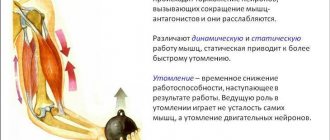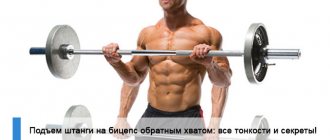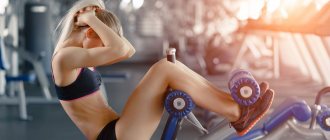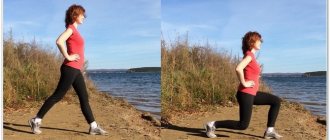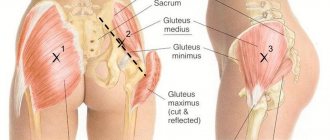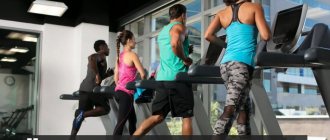Separation in bodybuilding
As you know, muscle mass builds up while working in basic exercises when using large weights.
Joe Weider recommends that both beginners and intermediate athletes concentrate their efforts on performing basic exercises. This means that sometimes over a period of 2 years, the goal of training is to develop basic abilities such as coordination of muscle groups, muscle mass, and strength development.
This stage ends after it has been possible to achieve large and proportionally folded muscle masses. That is, before starting the second stage of training, the athlete must form a critical mass.
According to Weider, critical mass is the minimum muscle development that allows you to begin competitive training. Just at this time, you can begin isolated work on individual parts of the body to develop separation and definition.
Separation is the distinct separation of one muscle group from another, and definition is the relief of muscle groups and intramuscular detail.
To achieve this result, you can use the principle of isolated exercises . Although the list of these exercises is quite varied, they all involve working only in one joint.
For example, in a standing barbell or dumbbell bench press , not only the deltoid muscles work, but the muscles of the shoulder girdle, forearms and back are also included in the work. This all leads to the fact that movement occurs simultaneously in the wrist, shoulder and elbow joints.
When performing lateral raises of dumbbells, standing with your arms fixed at the elbow joints, work is done only in the shoulder joint. And this includes the lateral heads of the deltoid muscles. And, despite the slight connection of the front and rear heads, the exercise is considered isolated, since the work occurs in one joint.
Let's look at the second example: barbell squats . This exercise involves the muscle groups that surround the hip, knee and ankle joints. And achieving isolated movement in one joint can be achieved by extending the legs while sitting on a special machine designed to train the muscles of the anterior thigh. This will force only the quadriceps to work.
That is, if an exercise involves more than one joint in the work, it is basic , if there is one that works like a lever, rotating at the point of rotation, it is isolated .
Joe Weider's system suggests that after working in the first stage for at least a year, building up body weight, when starting the second stage, the athlete must add one isolation exercise to the list of basic exercises used for each muscle group.
During training in the second phase, the barbell and simple equipment are no longer enough. Now you should use all kinds of exercise machines, the use of which helps the athlete better control the working muscles and include a larger number of muscle fibers in the exercise being performed.
To achieve maximum performance efficiency, isolated exercises should be performed at a relatively slow pace, controlling all areas of the range of motion.
This method of execution will contribute to better development of not only the muscles, but also their parts. In addition, by paying attention to movement control, you can learn to consciously control your muscles. And this will be useful later for practicing posing programs.
As for the third stage of training, if an athlete is going to compete, the goal here is to get rid of excess fat layers, create intermuscular separation and intramuscular detailing. This is what is called the definition of an athlete.
If fat loss is the result of reducing caloric intake, then intramuscular detailing can only be achieved through intensive use of the isolation principle.
Simply put, this means that as you get closer to the competition, you should reduce the number of basic exercises, increasing the number of isolation exercises . Vader believes that competitive training should last from 6 to 10 weeks.
When training in the first half of competitive preparation, you need to use a 50x50 ratio of isolating and basic exercises. Moving on to the second half of competitive training, you should use isolation exercises to a greater extent.
This is especially true for the last four weeks. Then you need to use basic exercises only where it is really necessary.
And one moment. During pauses during exercises, you need to practice posing. That is, during a pause, take a position that corresponds to a given muscle group and hold static muscle tension for several seconds, repeating this technique 3 to 5 times during the pause. This will sculpt the muscles even more.
Joe Weider System: Tips for Using the Isolation Principle:
- The isolation principle works best when using blocks, dumbbells and all kinds of machines.
- Isolated exercises should be performed slowly, concentrating on the working muscles, holding at the point of greatest muscle contraction for 2-3 seconds.
- To make the isolation principle more effective, when working one muscle or area, you should work it to the limit, without moving on to training other parts of the body until you finish working the first one. Let's look at an example. You train the upper chest muscles. You should finish working these muscles completely before moving on to other groups. For example, to the middle part of the chest or to the lower part of the pectoral muscles.
- You should perform at least 2-3 exercises on the area that you decide to work using the isolation principle.
- Do not perform isolation exercises using a swing or snatch. This reduces the effectiveness of the exercise.
- The isolation principle will not work if your body fat is more than 10% of your total body weight. That is, muscles will not be visible under the layer of fat.
Terms, abbreviations and jargon in bodybuilding
BB - bodybuilding.
An exercise is a specific movement that uses specific muscle groups.
A set is a continuous series of repetitions of an exercise.
Repetition is a movement or a series of movements in an exercise that make up one cycle. For example, in a squat, a repetition is bringing the body into a squatting position and then returning to a standing position.
Basic exercises are multi-joint exercises, i.e. exercises that work several joints on one side of the body. For example, pull-ups, where the elbow and shoulder joints work.
Isolation (isolation/isolation exercises) – exercises that involve one joint on one side of the body. For example, a barbell curl uses only one elbow joint on one side. Therefore, this is an isolated exercise. Although it is the biceps barbell lift that some consider to be the basic biceps exercise.
Superset (super series) – two exercises performed in a row without rest. Most often the muscles are antagonists, but not necessarily.
Triset – three exercises performed in a row without rest. The most suitable muscle group is the deltoids, because... they have three bundles: anterior, middle and posterior. An exercise is done for each beam. A triset can also consist of two exercises, when one of the exercises is done twice - at the beginning and at the end. For example, barbell curls, biceps curls, arm extensions, biceps curls.
Hyperset (giant set, giant set) – more than three exercises in a row without rest.
Circuit training (circuit training) is a training when a series of exercises are performed sequentially without rest, then there is a rest, and then this series of exercises is repeated. This series of exercises is a circle. It is a circle because the entire cycle is repeated several times, i.e. there is a circularity in the process - after the last exercise, the first one comes again. Essentially, one circle is a hyperset. Usually there are 6-10 exercises in a circle and each exercise targets a different muscle group. At the end of the circle there is a rest. Then the circle repeats. The minimum in circuit training is 2 laps (otherwise, what does the circle have to do with it?). Before starting, a warm-up is carried out; you can do a warm-up circle with lighter weights without failure. Before working exercises in the circle, warm-up approaches are not done. The working weights used are not very large, so that the number of repetitions is at least 15. Otherwise, the risk of injury increases, since there are no warm-up approaches immediately before the worker. Exercises are arranged so that they consistently engage different muscle groups. Otherwise, you may not be able to do the next exercise normally, because the working muscles are clogged with the exercise that just ended. If you do several exercises in a circle for one muscle group, then they should not be placed one after another so that the muscles have time to recover during the intermediate exercise on other muscles.
Circuit training is usually done for the purpose of burning fat or increasing endurance.
Training Volume – The total weight lifted during the workout. Sometimes defined as the total number of all sets of all exercises in a workout.
The intensity of the workout/exercise is close to the limit of ability in the exercise. For example, lifting the maximum weight 1 time is the maximum intensity in this exercise per unit of time for a given person. Sprinting to the maximum is also the maximum intensity in the exercise. In general, this is a relative indicator, since different people can show completely different absolute results at their maximum.
This term in strength sports is associated with the ultimate maximum (1RM or RM). For example, working in 80% PM mode. But even 1RM can change during one workout - it’s one thing to bench press fresh, and another thing at the end of a volume workout. I'm not even talking about changes in PM over a long period of time. It follows from this that you can work to the maximum with almost any weight. In essence, intensity is how much a person is giving out in the present moment, i.e. working to failure, the last failure repetition will always be at the limit of capabilities, i.e. as intense as possible. Since training consists not only of exercises, but of rest between them, the shorter the rest, the higher the intensity of the training as a whole, taking into account that the work is going to failure. If you work with a training partner or coach, then the intensity can be further increased through forced repetitions, since after failure occurs at a certain weight, the training partner takes away part of the load and you can continue to work at the limit of your capabilities. There are other ways to increase intensity.
The intensity of a workout or exercise can be measured by the average weight per repetition. This calculation does not take into account rest time, which means that by choosing the optimal rest time you can get maximum intensity. Therefore, such a measurement, in my opinion, is not particularly correct. Although, as one of the indicators, it may take place.
Often, training intensity is related to heart rate.
HR (heart rate) - the frequency of heart contractions (heartbeats) per minute.
Drying – getting rid of subcutaneous fat. Unlike weight loss, drying does not involve reducing body weight, but rather getting rid of subcutaneous fat. Despite the fact that body weight decreases during drying, this indicator is secondary. To lose weight, all you need is a diet, absolutely any one, the main thing is that the amount of energy expended is greater than that received from food. Drying is a much more subtle mechanism, where the preservation of muscle mass is extremely important. Therefore, drying requires a much more subtle approach to diet and necessarily involves exercise. Pre-competition drying also includes the so-called “draining of water”.
Split is a system for constructing a training process divided into muscle groups, i.e. when one part of the body is trained in one workout, for example, the chest, and other parts are trained in other workouts. The most common split consists of 3 workouts, although three-day splits can vary greatly from each other.
Fullbody/fullbody (FullBody) is a system for constructing a training process when the whole body is worked out in one workout. Of course, this does not mean that there was a targeted load on absolutely all muscles, but this, as a rule, means that there were exercises on the hips, lower legs, biceps and triceps, chest, latissimus dorsi, rectus abdominis. Forearms, neck muscles, etc. Usually they are not included in fullbody, because then the training would become too voluminous.
Antagonist muscles are muscles that perform opposite anatomical functions. For example, biceps and triceps - the biceps flexes the arm, and the triceps extends it.
Synergistic muscles are muscles that perform the same anatomical functions. This does not mean that some muscles completely duplicate others, but it does mean that several muscles are involved in one movement. For example, the bench press involves not only the pectoralis major muscle, but also the triceps and anterior deltoids.
Muscular fascia is a covering of muscles made of connective tissue.
A muscle bundle is a group of muscle fibers surrounded by a sheath. It is a structural unit of muscle. A muscle head or a group of muscle bundles that have similar contraction vectors and affect the same bones is often called a muscle bundle. For example, the posterior bundle of the deltoid muscle is not one bundle, but a whole group. The lateral triceps bundle is not a separate lateral bundle, but a separate head of the triceps, consisting of several bundles.
The head of the muscle is the part of the muscle that has its tendon in the proximal part.
Muscle separation is a visual separation of muscles and their elements. Separation is achieved primarily by reducing the amount of subcutaneous fat.
Failure (muscle failure) is a condition when it is impossible to complete a repetition that has been started. As a rule, when talking about failure, we mean several repetitions when the last one is a failure.
Cheating is a violation of the technique of performing an exercise. Cheating can be intentional and is used by experienced athletes, but it can be unintentional and is more common among beginners. For a beginner, cheating is always bad. For an experienced athlete, it can be a boon, but not necessarily. When cheating, the athlete uses additional muscles and energy to work, which allows him to lift more weight or do more repetitions.
Forced repetition (plus) – repetition performed with the help of a partner. Forced repetitions are not considered completed independently. For statistics it can be written as “plus”, for example, 8+2, i.e. 8 repetitions were performed without assistance, and the ninth and tenth repetitions were performed with the assistance of a partner.
Negative repetition is a “lowering” phase in a repetition, i.e. where the main working muscle is stretched rather than shortened.
Statics (static exercises) – exercises without movements. They involve keeping the weight stationary. A static exercise involves taking the desired position, i.e. There is still movement, and then you can lower the weight under load, i.e. There is also movement, but the main energy is spent precisely on holding weight (for example, the weight of your body) in a stationary state. Essentially, a static exercise is an exercise of one repetition with a stop at some point in the amplitude. As a rule, stopping occurs until muscle failure occurs and the muscle involuntarily lowers the weight.
Stato-dynamic repetitions are repetitions characterized by a partial amplitude that is in the middle of the range (without bringing the muscle to full contraction or full stretch). This technique is actively promoted by Professor Viktor Nikolaevich Seluyanov. Perhaps it was he who introduced this term, but it was he who ensured the popularity of the term.
Specialization - building the training process in such a way that the selected muscle receives a large load, but at the same time recovers normally. Specialization comes at the expense of other muscles, since the muscle that is focused on takes up training and recovery time. Specialization is usually used for lagging muscles to make the body look more proportional.
Cardio is a type of training in aerobic mode (aerobic exercise).
Aerobic exercise is exercise that uses oxygen to produce energy. These are low to moderate intensity exercises. For example, trotting is an aerobic exercise. Aerobic exercise can be performed for a long time (many repetitions).
Anaerobic exercise is exercise that does not use oxygen to produce energy. These are high intensity exercises. For example, sprinting is an anaerobic exercise. Anaerobic exercise cannot be performed for a long time - muscle failure quickly occurs.
Metabolism - metabolism. Consists of anabolism and catobism.
Anabolism is the chemical processes leading to the formation of body tissues. The opposite process is catabolism.
Catabolism is the breakdown of organic substances with the release of energy. The opposite process is anabolism.
Glycogen is a complex carbohydrate stored in the human body. It is stored mainly in muscles and liver. Used by the body as a source of quick energy (body gasoline).
Walking – determining your one-time maximum in an exercise, i.e. determining your 1RM (single maximum maximum) by performing the exercise to the limit of your capabilities. Periodic walking allows you to track the dynamics of your training process.
A chemist is an athlete who uses exogenous hormones.
A natural is an athlete who does not use exogenous hormones. The use of sports nutrition, for example, protein or amino acids, is not a reason to consider an athlete a chemist.
An Orthodox natural is an athlete who does not use exogenous hormones or sports nutrition. It is not entirely clear whether they allow themselves products containing various additives, incl. the same whey protein concentrate. If you are a completely orthodox naturalist, then most industrial products cannot be eaten (sausages, canned food, cakes, etc., etc.). If you give up only sports nutrition, then this looks more like an oddity rather than a principled approach. It's like a vegetarian who still eats fish or some type of meat.
Vitamins – if not in the sense of vitamin-mineral complexes, then we mean supervitamins.
Supervitamins are exogenous hormones.
Exogenous hormones are hormones obtained from the outside.
Endogenous hormones are hormones produced in the body and used by it.
Dough is the hormone testosterone.
Gormoshka – hormones (sometimes specifically growth hormone). As a rule, we mean exogenous hormones.
A course is a course of exogenous hormones (or one hormone) similar to the course of treatment for other medications.
Solo – a course with one hormone.
Compote is a course with several hormones.
Steroids are, in a broad sense, exogenous hormones. In a narrower sense, it is steroid hormones, i.e. for example, growth hormone (somatotropin) in this case does not apply to steroids.
PCT (Post Cycle Therapy) – post-cycle therapy. A course of medications to reduce the negative consequences of the use of exogenous hormones.
A bar is a part of a barbell or dumbbell in the form of a stick, on which you can put special discs (plates) and locks so that the plates do not slip.
An Olympic bar is a bar whose mass is 20 kg, length – 2.2 m, diameter – 28 mm. Bushings for discs (pancakes) at the ends of the bar with a diameter of 50 mm. The bushings can rotate independently. The locks for this bar weigh 5 kg per pair, that is, together with the locks, the bar weighs 25 kg.
EZ-neck is a shortened W-shaped neck. Used primarily to relieve stress on the wrists with a narrow grip, such as biceps and triceps exercises. Weight may vary and ranges around 13 kg.
Pancakes (discs) are discs worn in pairs on the bars to increase the weight of the projectile. There are different diameters of disc holes. The most common internal diameter of the discs is 51 mm (this is what is used for the Olympic bar).
A lock is a device that secures pancakes to the bar. Locks are often incorrectly called "clamps".
Quick release lock – a special lock design for quick putting on and taking off. The most common are spring quick-release locks.
Fitbar is a gymnastic stick. Fitbars have different weights and can be used, incl. like light barbells.
Fitball is a fairly light ball from 55 to 75 cm in diameter for sports exercises. Mainly used as a support, i.e. They lie on it, sit on it, put their limbs on it. Its instability and some deformation when pressed give it the necessary qualities for certain exercises. The fitball is a very versatile piece of equipment that allows you to put stress on different muscles. Initially, fitball was used to treat patients with cerebral palsy.
An expander is a portable, compact sports equipment for compression or stretching. One of the most famous is a rubber carpal expander (reminiscent of a steering wheel). An expander can be in the form of an elastic cord several meters long without handles or any other elements.
Bridge (pave) - arching in the back. Most often, the bridge is used in the bench press on a horizontal bench. In this case, the bridge allows you to perform the exercise with more weight, since the amplitude of the movement decreases (the chest becomes higher), and the trajectory of the movement changes - the press gets shifted downward (towards the legs), and it is also possible to better connect additional muscles. The bridge is widely used in powerlifting and power bench presses. In bodybuilding, the bridge is rather harmful, since the load is diffused across many muscles - a lot of force is spent, and not all of the load falls on the target muscle group (the pectoralis major muscle). The bridge can be with or without lifting the pelvis off the bench. A pelvic lift is considered a technical violation in strength competitions and such lifts are not counted. Also, separation of the pelvis puts increased stress on the lower back, which can lead to injury. A bridge with a separation of the pelvis will further remove some of the effort during the exercise from the target muscle group. At the same time, a pelvic lift bridge can help you learn to include your legs in the bench press.
Supination is an inverting rotational movement of the limb around its axis. For an outstretched arm, the palm-up position is supinated.
Pronation is a tilting rotational movement of a limb around its axis. For an outstretched arm, the pronated position is palm down.
Straight grip - pronated grip, i.e. when a projectile (bar, horizontal bar, etc.) is grasped from above with your fingers. If your hands are above your head, then your palms are facing forward, if your hands are below, then your palms are facing back.
Reverse grip – supinated grip, i.e. when a projectile (bar, horizontal bar, etc.) is grasped from below with your fingers. If your hands are above your head, then your palms look back, if your hands are below, then your palms look forward.
Parallel grip - a grip with your palms facing each other. Typically, a parallel grip involves a two-handed grip, while forward and reverse grips often involve one-handed grips.
Monkey grip (open grip) - a grip where all fingers clasp the apparatus (bar, horizontal bar, etc.) on the same side.
Closed grip - a grip where the thumb clasps the implement (bar, horizontal bar, etc.) on the opposite side of the other fingers.
Lock grip (lock grip) – When talking about a lock grip, we mean a closed grip where the thumb is held between the index finger or the index and middle fingers. The lock is used to ensure that the bar does not fall out of your hands as it rotates when the weight on the bar is large enough.
Different grip (mixed grip, combined grip) - a grip when one hand is in a supinated position and the other in a pronated position, if the implement (bar, horizontal bar, etc.) is located parallel to the shoulder line. If the projectile is perpendicular to the line of the shoulders, then the different grip can be a parallel grip along the crossbar. The mixed grip is mainly used to ensure that the bar does not fall out of the hands while scrolling when the weight on the bar is large enough.
Rods (wrist straps) are special belts, less often hooks, that allow you to hold a projectile without using a lock or a different grip.
Dips are the best exercise for muscle separation (chest muscles, triceps)
Today, modern exercise equipment has almost completely replaced the old, familiar equipment in most gyms. Of course, simply repositioning the stopper on a set of weights significantly reduces the time it previously took to change discs on a barbell. Perhaps the fear of returning to the prehistoric times of weight training has caused us to retreat from the true mainstays of bodybuilding that have helped many past athletes achieve progress over the years. The dip is one of those exercises from ancient times that has served bodybuilders well in the past, but does it meet the demands of modern training philosophy? Of course, you won't have to struggle with the barbell, but you will be forced to use something not entirely convenient - your own weight. However, this exercise requires very simple equipment - parallel bars, which do not even need chrome plating to give the desired result. This is the best exercise for developing the pectoral muscles and triceps, not to mention the numerous auxiliary muscles of the shoulder girdle.
Separation, definition, muscle depth. Author Alexander Kasap
Separation, definition and muscle depth are important criteria in a bodybuilder's performance and can be the key to victory or defeat on the platform. Let's look at these concepts in more detail:
Muscle separation is a phenomenon in which the naked eye can see the separation of muscle groups and their distinct outline. That is, a clear separation of one muscle group from another should be visually visible. And even if an athlete has a low percentage of subcutaneous fat, but there is no separation of muscle fibers, his success on stage raises significant doubts. For example, many still remember the outstanding muscular separation of Andreas Münzer's muscles, their separation is so obvious that it cannot but cause admiration. Achieving it is not a simple trivial task, first of all it should be what can be subjected to separation - a sufficient amount of muscle tissue, which is achieved by hard work while performing mainly basic multi-joint exercises. After there is a sufficient volume of muscle tissue, each muscle fiber begins to be worked on through isolated single-joint movements in simulators or with dumbbells, where each athlete must choose his own angle for working a specific muscle fiber, since each individual has his own unique attachment of muscles to joints, which is determined genetically. If we talk about the author, then in relation to the chest, preference is given to exercises on the crossover, since the plastic cable system allows you to choose the best angle for working out individual fibers, it is also very convenient to use one dumbbell on a horizontal bench in a lying position on your side where it is raised up under at the required angle, the hand is strictly fixed and used as a lever. Another important aspect of muscle separation is posing, that is, tension and holding it in the target muscle group with short breaks for relaxation, repeating this maneuver several times (in fact, the separation becomes more pronounced).
Definition is a visual breakdown of muscle fibers into individual fibers due to the low percentage of adipose tissue in the body. By reducing the level of fat and removing excess water, the skin tightly fits the muscle fibers, emphasizing and detailing the athlete's developed muscles. However, the definition is not simply the release of muscle fiber through fat burning; anyone can lose fat through diet, but will not have the muscle cut that bodybuilders have. In order to achieve the desired state of the muscle fiber, its hyperplasia (increase in the number of muscle fibers) is necessary; this is achieved both through good old volumetric training and through pharmacological support (growth hormone). Of course, the steroids themselves indirectly also contribute to hyperplasia, since the muscle fiber is not able to grow more than twice, then AS accelerate this process, followed by hyperplasia inevitably occurring for further adaptation to the load, and the use of AS (especially trenbolone) increases the level insulin-like growth factor type 1 directly promoting muscle fiber hyperplasia. Subsequently, the fascia of the new muscle fibers must be filled with myofibrils to increase muscle density (that is, volumetric training is replaced by training for myofibril hypertrophy). Further drying and removal of water only emphasizes the progress achieved by training. This approach leads to the cross-section of fibers that you see when athletes pose. To summarize, we can say that the definition is a combination of a low percentage of fat, hyperplasia and sufficient fullness of muscle fibers.
According to the author, the presence of muscle depth is a combination of a number of factors: the total volume of muscles, sufficient separation and definition, which leads to a pronounced depth of muscle drawing.
Thus, a number of important factors in assessing competitive athletes were considered, the author hopes that the article was informative.
Specialization in bodybuilding is a type of training aimed at the specific development of a specific muscle group. As a rule, we are talking about lagging muscle groups.
If you have already read articles or even perhaps books about specialization for lagging muscle groups, then you have a rough idea of what it is. If not, then I will say that advice regarding the specialization of individual muscles mainly boils down to increasing sets, exercises or training for certain muscles.
However, what is the end result? Has the muscle on which special emphasis been placed increased in volume? In most cases, the result is depressing - overtraining and disappointment.
However, there is a solution to the problem of specializing difficult to respond muscles. Unfortunately, even professional bodybuilders or trainers do not always know about it.
Specialization for genetically gifted athletes
If a certain muscle group stubbornly refuses to grow, then the first thing to do is look at your training program and find what is preventing the lagging muscle from growing . For example, if the biceps does not respond, you need to see if it is loaded on other days when it is not specifically trained. And the biceps can get a load when training the back, when doing bent over rows or pull-ups. If the answer is yes, you know that your biceps simply do not have time to recover and therefore do not grow.
The root of the problem of lagging muscles is related to overtraining:
| Indirect + direct load = under-recovery. Underrecovery → overtraining |
Moreover, overtraining of a particular muscle group over time leads to the fact that progressive muscles begin to hypertrophy poorly.
Therefore, the first thing that needs to be done is to rebuild the program so that the muscles receive stress exclusively on the days allotted for them. No matter how hard you try to isolate your back, you will not be able to eliminate the work of the biceps, even if it is not intense. Therefore, if your biceps are really lagging behind, train them on the same day as your back.
The second tip is to reduce the amount of work on the lagging muscle . Do this for a specific (short) period of time. It is best to keep the work to a minimum: perform just one exercise in several working approaches. Only after a reduced workload can one move on to specialization in its classical sense, reasonably increasing the volume and intensity of work.
If you train 3 times a week, then the split should be planned in such a way that on one day (the first of the week) you work with the lagging muscle group, and on the other two - with the remaining muscle groups. Moreover, it is very important that on the other two training days the intensity of the training is not high. Moreover, during the period of specialization, when the emphasis is on the problem muscle, a greater effect should be expected if you slightly slow down the momentum on the progressing muscles. This will keep the progressing muscles at their current level and tighten the muscle group that refused to grow.
Specialization for hard gainers (genetically ungifted athletes)
Hardgainers are distinguished by the fact that they work on reduced programs. For them, high-volume and high-intensity training, as a rule, does not bring results. It is best for hardgainers to train 1-2 days a week, using a small number of basic exercises. It would seem, what kind of specialization could there be for hardgainers if, by and large, they strive to load not so much individual muscles as the muscular system of the body as a whole, thereby triggering anabolic changes throughout the body? But not everything is so simple. For them, specialization also has a place.
For hardgainers, specializing means moving to training that consists of just one exercise. The duration of the specialization period is about 4-6 weeks. Ultra-hard gainers, that is, those who progress extremely slowly, should practice specialization regularly. Specialization gives hardgainers an increase in the mass of those muscle groups that take the most active part in a particular exercise.
During the period of specialization, you should choose from exercises that involve the maximum number of muscles. In my opinion, the deadlift is best suited for this role. It actively engages both the upper and lower body. At the same time, there are programs consisting of squats alone, during which not only the legs, but also other muscles of the body are involved in the work. It is possible that good results can be expected by specializing in the bench press or standing press, pull-ups or dips.
2013 © h2g.info
Execution technique
Initial position
- The exercise is performed with barbell weights. You need to take light weight discs and hold them between your palms;
- It is convenient to hold the discs with your fingers so that they do not slip;
- The movement is performed from a straight stance;
- Hands, palms pressed one against the other, are brought to the level of the middle of the chest;
- The elbows need to be spread apart so that the forearms are in the plane of the floor;
- The discs need to be squeezed with your palms, pressing one against the other. Isometric tension of the chest muscles is performed at the start of the movement
Movement
- As you exhale, you need to press the plates forward, tensing your chest muscles;
- The movement occurs before extension in the elbow joint, but there is no need to fully insert the elbows;
- The pancakes move forward along a trajectory that lies in the plane of the floor;
- Then the pancakes are brought to the chest;
- The exercise is performed for the planned number of repetitions, while the trajectory does not change
Attention
- Fixing the discs by placing your fingers in the bar hole is not optimal, it takes the stress off the chest muscles. The point here is not to take the heaviest plates you can hold, but to hold them by compression;
- The elbows should be approximately in line with the center of the chest; lowering them down shifts the load on the biceps;
- The exercise should not be performed with pauses to rest on the chest, and cannot be considered performed correctly if the athlete initially brings the discs upward, towards the eyes, partially performing the movement due to the anterior deltoid;
- The movement is not performed with extreme weights, even if the athlete is very strong in the bench press and other chest movements. The point of the exercise is a combination of isometric and dynamic work, otherwise the movement will already resemble a regular bench press, moreover, performed in a trajectory that is unsuccessful for working out the chest
Pre-depletion method
Sometimes athletes fail to engage large muscle groups well because the supporting muscles are already tired. For example, when the lower back is already seriously loaded, you will not be able to give the maximum load when squats. The pre-exhaustion method involves working the large muscles to the point of severe fatigue through an isolation exercise and then performing a compound exercise. Of course, the working weight for the basic movement should be reduced.
Recommendations
- Keeping the shoulder parallel to the floor along with the forearm allows you to emphasize the load on the chest. The more the athlete brings his elbows down, the more the load shifts to non-target muscles - the anterior deltoids and biceps;
- The upward press is acceptable, but it involves the shoulders to a significant degree and is not recommended for those whose goal is focused work. If you add a little shoulders, it’s not a problem, you can work like that;
- It is not recommended to “work” with your back; by stretching and contracting the lats, any pressing movement will be simpler;
- The movement should not be performed with pauses on the chest;
- If your hands slip, it makes sense to wear gloves;
- The weight of the projectile should be reduced if it is not possible to maintain the trajectory. Beginners start with one pancake.
Execution options
The Svend press can be performed lying on a straight or incline bench to remove some of the load from the front deltoids and stabilizer muscles. This allows beginners to do the exercise too.
On the bench, you should also concentrate on squeezing the discs with your hands and pressing them forward, and not just moving solely with your hands. The exercise will be less difficult than the standing version, but can be useful for beginners. It will provide very little benefit to those who continue, unless it is performed as a “finisher” at the end of a workout or as part of some kind of superset.
Forced repetition method
When using this method, you will need the help of a friend. Its task is to assist in performing two or three repetitions after completing the main ones. You need to do as many reps as possible on your own before you need help. The partner needs to feel when help is needed in order to relieve some of the burden at an inopportune moment.
Analysis of the exercise
What muscles work
Core muscles . The pectoralis major works as the main one.
Supporting muscles are the pecs, triceps, deltoids, and abdominals. The latissimus dorsi muscles are partly involved.
Advantages
- It is difficult to get injured in this movement due to the weight of the projectiles. The athlete cannot get a pectoral tear, tear, or sprain due to the fact that he simply does not use the weight of the weights, which could provoke the problem;
- The exercise can be included in work in any gym, even if there is no crossover, block exercise machine or exercise machine for bringing the arms in front of the chest (“butterfly”);
- The movement is suitable for men and women, beginners and advanced;
- Doesn’t require a lot of space or equipment, so it’s suitable for an evening workout in a busy gym after work;
- Can be used as an auxiliary exercise for the bench press.
Flaws
Apparent simplicity is deceptive. The exercise exposes all muscle imbalances and posture problems; a person with a weak back will slouch and will not be able to do the movement correctly. Someone with weak front deltoids will experience muscle "failure" in them, but will be able to continue
Proper execution
- It is allowed to press either diagonally upward or in the plane of the floor;
- The movement combines the simultaneous squeezing of the palms one to the other and a pressing movement;
- The press is performed strictly while exhaling;
- The trajectory of all repetitions must be the same;
- The weight of the shells used is light.
Errors
- Execution with unbearably heavy weight;
- Changing trajectory, lowering elbows;
- Performed at half amplitude;
- Holding the plates rather than squeezing them in front of the chest
Efficiency Tips
- It is optimal to perform the movement with plates, and not with a medicine ball or dumbbell. You can complicate the exercise by using more than 2 pancakes;
- The movement will be more effective if the emphasis is not on the press itself, but more on the compression;
- The exercise should not be performed in different planes, starting with the press up and ending parallel to the floor. The movements should more or less repeat each other
- For the best pump, you need to work at a good pace and not push your elbows in all the way.
Features of hand training
All muscles of the body are subject to the same laws of biology, and, therefore, athletes should use a stress-recovery scheme to obtain maximum results.
However, in practice, many athletes pay great attention to isolating movements and do not progress the load. In this case, hope for muscle mass growth. This is a very complex biological process of adaptation of the body to constantly increasing physical activity. You must understand that you will be able to progress by increasing the load on the target muscles. Since the arms are significantly inferior in strength to other muscle groups, and especially when they are lagging behind in development, it is necessary to isolate them. You must shift your priority to exercise technique.
For these purposes, it is advisable to use devices for fixing the elbow joints when performing biceps exercises, for example, California bench press or reverse grip press, when training triceps. A Scott bench can be an excellent device for fixation. And, let's say, Arnie used a nylon belt for this.
You also need to correctly manipulate the working weights so that your technique does not suffer as the load progresses. It might look like this: Once you've done 15 or 16 reps with one weight, increase it. After this, start with 12 repetitions and gradually increase their number to 15 or 16 and increase the weight again.
You can do hand training once every 3 or 4 days. This is due to the fact that small muscle groups recover faster compared to large ones. But the duration of the training and its volume must be reduced. The presence of overload will be indicated by pain in the muscles. If you have a sore throat, then you have overloaded your muscles and a large amount of lactic acid interferes with the production of protein compounds.
Thus, the most important thing when training your arms is the progression of the load and the correct technique. You must choose working weights that will not compromise your technique, while not forgetting about progression. If in your training program more than one lesson is allocated for arm development during the week, then the remaining groups should be trained only to maintain shape.
Inclusion in the program
The exercise cannot be the only movement on the chest. Since it is formative and pumping in nature, it is added either as part of chest supersets or at the end of the workout. After the Svend press, it is not necessary to perform flyes with dumbbells or in a crossover; moreover, it is strictly not recommended, because there is a high risk of injury to the middle of the chest.
The Svend press is done in a relatively high repetition mode, for 8-15 repetitions, sometimes for more repetitions if the athlete tolerates static work in this exercise normally.
What to replace
The exercise is so undemanding on equipment that it is usually not necessary to replace it. Almost everyone can find a pair of discs in their gym and perform the Svend press with them. But if a replacement is needed, it resembles the movement of mixing with a pause in the crossover, to the cables of which rubber shock absorbers are attached. It is this variation, especially with a pause in the middle of the amplitude, on the chest, that leads to the most complete “squeezing” of the chest muscles.
You can also replace the exercise by isometrically bringing your palms together in front of your chest. But this replacement relates, rather, to women's training, and not to bodybuilding.
Supersets with the Svend press should be structured in such a way that the chest stretching exercise comes first, and then the press. For example, it makes sense to perform the crossover in front of the chest first, and then the Svend. The same is true for dumbbells.
Beginners can try doing a superset of this movement to strengthen the muscles without overloading the stabilizers and causing poor technique. A well-known superset is also the wide-arm push-up and the Svend press.
The exercise can be performed with a medicine ball or shock absorber, then part of the emphasis will shift to the triceps. There are not many contraindications to the Svend press. Although this is not a strength exercise, it is not recommended for rehabilitation purposes for people with chest injuries, rotator cuff tears, or other shoulder injuries. In this case, you need to wait for complete recovery, and only then include the static load in the plan.
